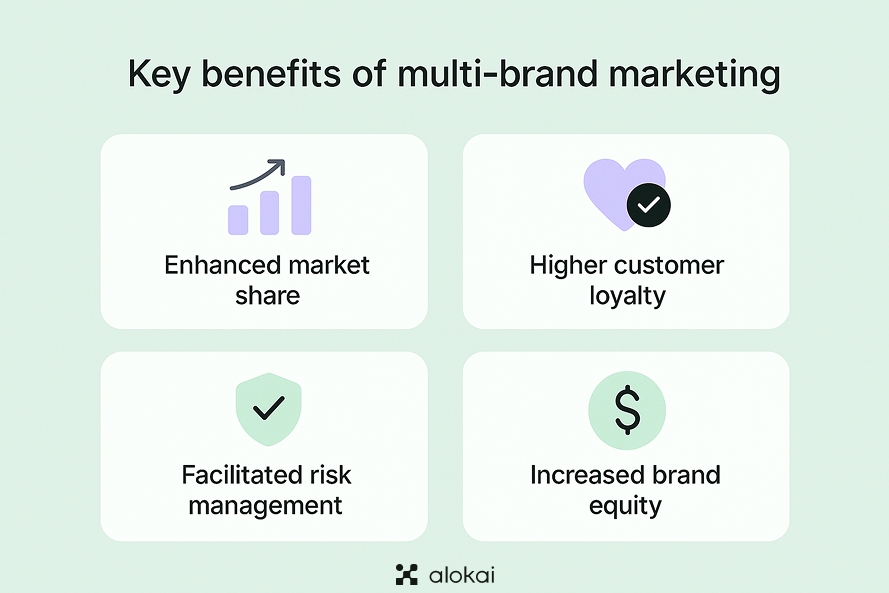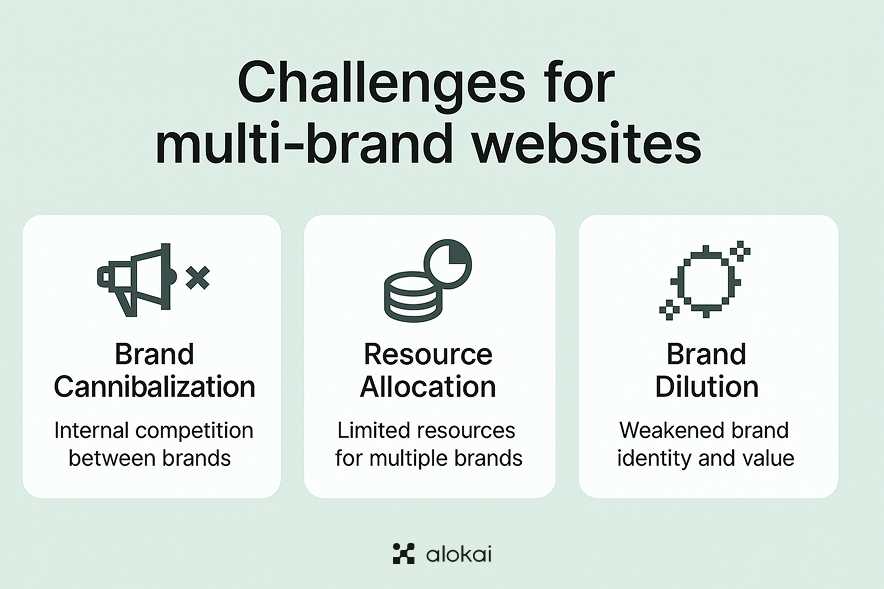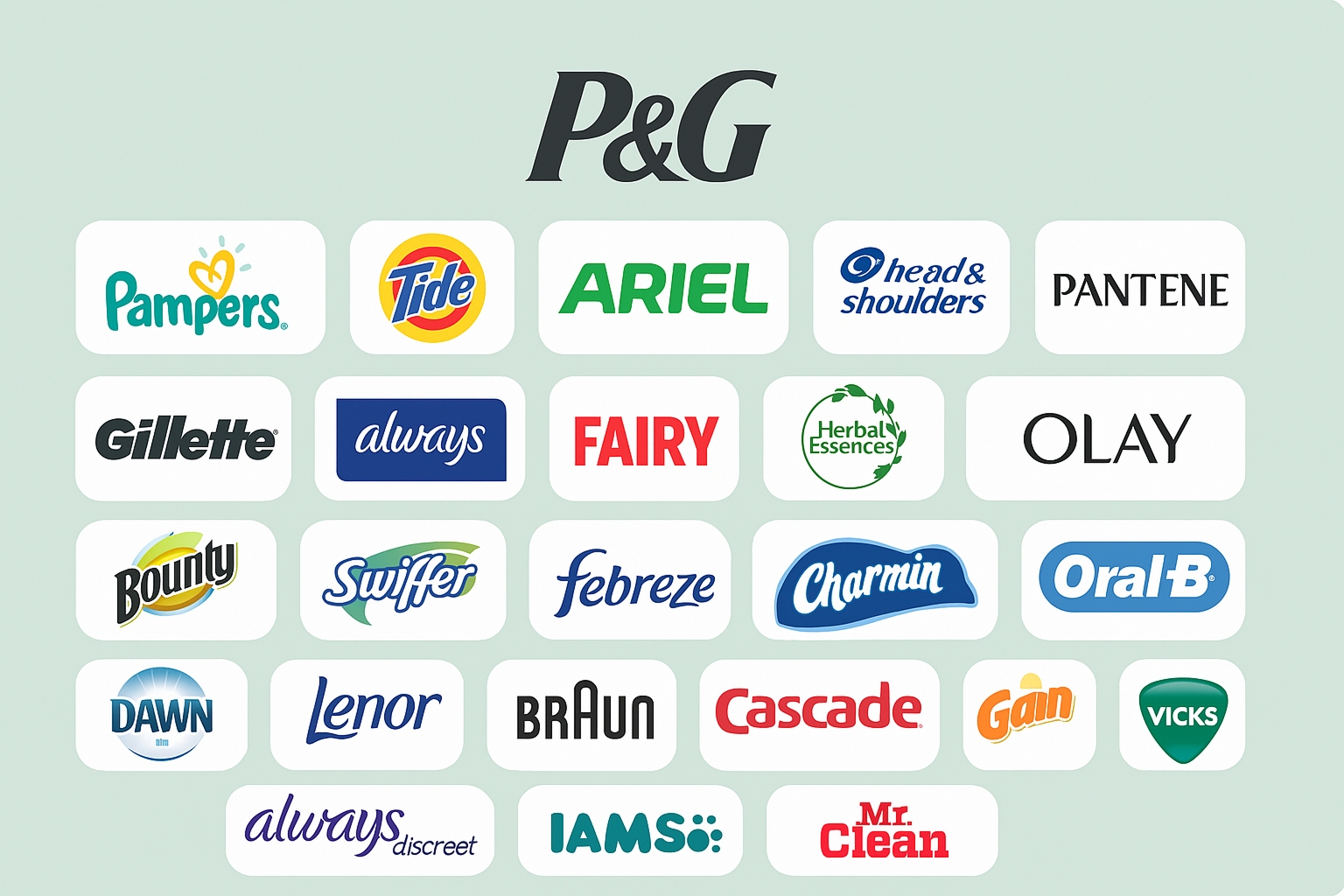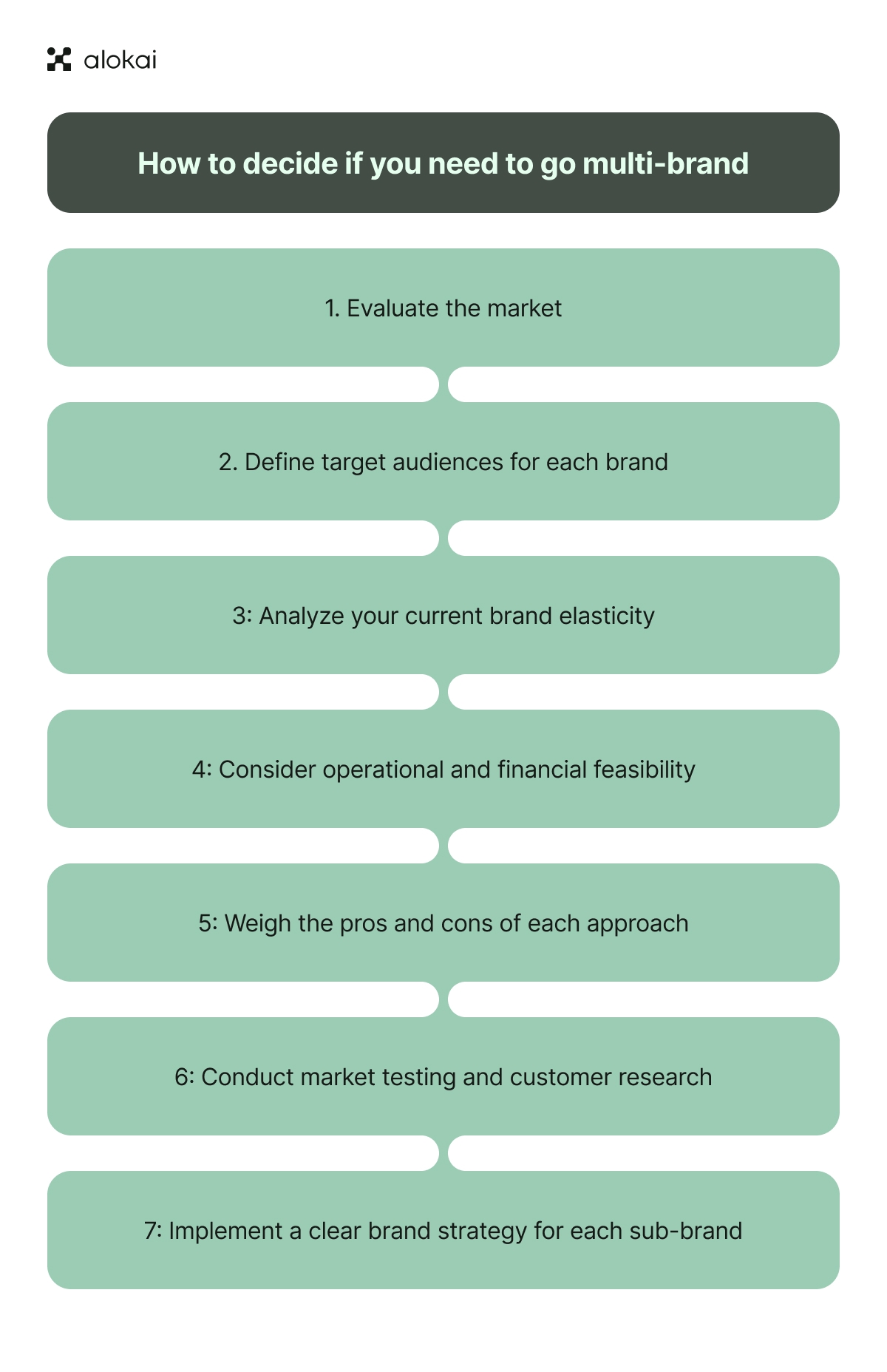Company giants excel in their markets by managing multiple brands under one umbrella. By employing a multi-brand strategy, they effectively capture diverse segments, allowing them to meet varied consumer needs while maximizing their reach and influence.
Although their brands may compete for consumer attention, they are strategically positioned to capture different market segments, ensuring that the overall brand portfolio maximizes market share and caters to diverse consumer preferences.
In this article, we’ll detail multi-brand marketing, its main benefits, challenges, and strategies for success.
Key takeaways
Multibranding strategy enables companies to target diverse consumer segments, enhance market reach, and reduce internal competition.
Key benefits of multi-branding include risk diversification, increased customer loyalty, and enhanced brand visibility, collectively strengthening market position.
Successful multi-brand management requires clear brand differentiation, targeted marketing, and efficient resource allocation to maintain brand integrity and avoid issues such as cannibalization and dilution.
What is multi-branding?

Multi-branding is where companies market multiple brands within the same product segment to target different consumer groups. This approach involves introducing products under different brand names, each tailored to capture a unique market share. The primary goal is to reduce internal competition, enhance revenue streams, and appeal to specific new audiences.
Take Nestlé, for example. They cater to various target audiences and consumer preferences with an array of distinct brands including drinks (Nesquik), ice cream (Haagen-Dasz), chocolate (KitKat), water (Perrier), and even petcare (Purina).
L’Oréal follows a similar path, offering a perfect choice of brands for all consumer needs and desires, catering to a diverse audience—Valentino, Kerastase, La Roche Posay, Garnier are all examples of companies operating under L’Oreal Groupe.
Toyota also adopted a multibrand strategy to introduce a touch of luxury into the market with Lexus cars.
A multi-branding strategy enables companies to cater to different consumer needs while maximizing their market influence. It’s a strategic approach that broadens market reach, enhances customer loyalty, and mitigates risks.
Types of multi-brand strategies
There are several types of multi-brand strategies, each serving different business objectives and market needs:
House of brands: The parent company owns multiple distinct brands, each with its own identity and audience (e.g., Unilever with Dove, Axe, and Ben & Jerry’s).
Branded house: The parent brand dominates while sub-brands exist as variations under its umbrella (e.g., Google with Google Maps, Google Drive, and Google Ads).
Endorsed brands: Sub-brands have their own identities but are visibly linked to the parent company for credibility (e.g., Marriott with Courtyard by Marriott and Ritz-Carlton by Marriott).
Hybrid strategy: A mix of the above strategies, where some brands stand alone while others are connected to the parent brand (e.g., Coca-Cola with Coke, Sprite, and Fanta as standalone brands but "Diet Coke" and "Coca-Cola Zero Sugar" leveraging the parent name).
Fighter or Flanker brands: Lower-priced or niche brands created to compete in specific segments without hurting the main brand (e.g., Toyota with Lexus for luxury and Scion for youth markets).
How does a multi-brand strategy differ from a single-brand?
The key differences between multi-branding and a single-brand strategy include:
Aspect | Multi-brand | Single-brand strategy |
Definition | Multiple distinct brands under one company | One brand for all products |
Market focus | Targets different customer segments | Focuses on a unified brand identity |
Risk management | Diversifies risk across multiple brands | Higher risk if the brand underperforms |
Marketing strategy | Requires separate marketing efforts for each brand | Consistent branding across all products |
Example companies | Unilever (Dove, Axe, Magnum), Procter & Gamble (Tide, Gillette, Pampers), etc. | Apple (iPhone, Mac, iPad under one brand), IKEA, etc. |
A single-brand strategy works well for companies that want a strong, unified brand presence while multi-branding is ideal for those looking to diversify and dominate multiple market segments.
Key benefits of multi-brand marketing
Adopting a multibrand strategy offers several key benefits that can significantly enhance a company’s market position and profitability. These advantages extend beyond market share, influencing customer loyalty, risk management, and brand equity.
Multi-branding enhances market reach, diversifies risks, and fosters customer loyalty. The following subsections detail these aspects.

Enhanced market reach
A multi-brand strategy significantly increases brand visibility in the market. Targeting different segments with different brands substantially boosts brand awareness and sales. This approach allows businesses to create separate but related products for different target groups, effectively enhancing their market presence.
Having several brands means catering to varying customer needs, which attracts a diverse clientele. This diversity expands customer reach and provides opportunities for cross-selling and upselling. An effective multi-brand strategy increases overall market presence and a broader customer base.
Moreover, by offering various brands, companies can maintain profitability during economic changes by shifting focus to affordable or premium brands as needed. Competing in various segments creates opportunities for easier market domination with less shelf space available to competitors.
Risk diversification
One of the most compelling advantages of multi-branding is risk diversification. Operating multiple brands under one umbrella allows for better risk management and provides a buffer against market fluctuations. This approach reduces risk exposure, as the failure of one brand typically will not greatly affect total sales.
A diversified brand portfolio stabilizes business performance, ensuring that fluctuations in one segment do not significantly impact the business's overall stability.
In essence, multi-branding diversifies revenue sources and enhances resilience against market volatility.
Increased customer loyalty
Offering multiple brands satisfies customers’ desire for diversity and encourages brand exploration. This variety can enhance customer satisfaction, as different brands cater to different consumer preferences. Addressing these varied preferences fosters greater customer loyalty.
Also, loyalty programs that reward purchases across brands can significantly increase customer retention. Positive experiences with one brand will likely lead customers to try other brands from the same company, further strengthening customer loyalty.
Challenges in implementing multi-branding strategies
While multi-branding offers numerous benefits, it also presents several challenges that companies must navigate carefully, including disadvantages. These challenges include brand cannibalization, resource allocation, and brand dilution, each of which can undermine the effectiveness of a multi-brand strategy.
Recognizing these challenges helps businesses develop robust strategies to mitigate risks and ensure the success of their multi-brand approach.

Brand cannibalization
Brand cannibalization occurs when competing brands within the same company eat into each other’s market share, leading to a loss of sales. If these competing brands do not effectively enhance each other’s proposals, profitability and market share can decrease.
Furthermore, significant brand overlap can cause customers to leave the brand umbrella, exacerbating the issue of cannibalization. Companies must differentiate their brands clearly to prevent internal competition from eroding overall sales.
Resource allocation
Efficient resource allocation is crucial for maintaining the quality of products and services across multiple brands. Inefficient resource distribution can compromise overall quality and operational efficiency, leading to potential market failures.
However, cost savings and operational efficiencies can be achieved through marketing efforts, R&D, and manufacturing, enhancing resource management. Balancing resource allocation while preserving product quality is essential for the success of a multibrand strategy.
Brand dilution
Brand dilution occurs when the expansion of the brand portfolio weakens the equity and recognition of individual brands. Expanding without strategic focus can lead to loss of brand identity and consumer trust, ultimately weakening overall brand equity.
Companies must ensure that each brand within their portfolio maintains a strong, unique identity and brand reputation to avoid brand dilution.
Effective strategies for managing multiple brands
Successfully managing multiple brands requires strategic planning and execution. Key strategies include:
Clear brand differentiation;
Targeted marketing campaigns;
Leveraging digital tools;
Unified but flexible governance;
Cross-brand synergies.
Each of these helps companies navigate multi-branding complexities and achieve sustainable growth.
Clear brand differentiation
To perform well in a multibrand strategy, each brand must have a distinct identity. Clear differentiation helps prevent customer confusion and ensures that brands do not cannibalize each other’s market share. A unique value proposition for each brand strengthens market positioning and enhances customer loyalty.
Unilever’s personal care brands, such as Dove and Axe, cater to specific consumer groups. Dove promotes self-esteem, while Axe appeals to young men.
Maintaining clear and distinct brand identities is essential to avoid consumer confusion and ensure effective multi-brand marketing.
Targeted marketing campaigns
Strong multi-brand marketing campaigns are crucial for launching new products and maintaining brand presence. When introducing a new product, companies should create campaigns aligned with their business goals and tailored to specific market segments.
Analytics technologies play a vital role in evaluating the success of these campaigns, helping companies adjust their strategies based on data-driven insights. This targeted approach ensures that each brand effectively reaches its intended audience.
Leveraging digital tools
Digital tools like Salesforce and HubSpot can significantly improve efficiency in managing many brands. Marketing automation provides advantages such as saving time and offering analytics and reporting capabilities.
Effective sales tracking, management, and closing enhance customer interaction and measure the effectiveness of marketing initiatives using data and analytics technologies.
Case studies of successful multi-brand companies
Examining successful multi-brand businesses provides valuable insights into effective strategies and practices. Companies like Procter & Gamble and Unilever, the parent company of multiple brands, have mastered the art of managing multiple brands, each with its distinct identity and market presence.
Procter & Gamble

Procter & Gamble’s diverse brand portfolio includes well-known brands such as Pampers, Gain, Tide, Pantene, Always, Crest, and Braun. Each brand addresses essential consumer needs, from daily-use cleaning to health and hygiene. Consumers trust P&G brands to provide the highest quality, superior performance, and value, making P&G a leader in the multi-brand arena.
For example:
Pantene vs. Head & Shoulders – While both are haircare brands, Pantene is marketed toward consumers looking for smooth, shiny, and healthy-looking hair, often targeting women, while Head & Shoulders focuses on anti-dandruff solutions and has broader gender appeal, especially among men concerned about scalp health.
Tide vs. Dreft – Tide is marketed as a powerful detergent for general household laundry, whereas Dreft is a specialized detergent for baby clothes, targeting parents who want a gentle formula that’s safe for newborns.
Unilever

Unilever’s commitment to sustainable living across all its brands sets it apart in the multi-branding world.
Some of Unilever’s well-known brands include Axe, Dove, Pond’s, Magnum, and Ben & Jerry’s, catering to different consumer preferences and needs.
For example:
Axe vs. Dove – Axe (Lynx in some markets) is positioned as a bold, edgy grooming brand for young men, using humor and aspirational masculinity in its marketing. Dove, on the other hand, focuses on self-care and body positivity, particularly targeting women with its “Real Beauty” campaign.
Lipton vs. Pure Leaf – Lipton is a mass-market tea brand associated with affordability and tradition, appealing to families and everyday consumers, while Pure Leaf is marketed as a premium, authentic tea brand with a focus on natural ingredients, targeting health-conscious and upscale buyers.
Ben & Jerry’s vs. Magnum – Ben & Jerry’s focuses on fun, quirky flavors, social activism, and a younger, more progressive audience. Magnum, on the other hand, positions itself as a luxury ice cream brand for indulgence, using rich, sophisticated imagery to attract an adult demographic.
How to decide if a multi-brand strategy is right for your business
Determining whether a multi-branding strategy suits your business requires careful evaluation of market segments and internal capabilities. Understanding your business’s purpose, identifying the target audience, and recognizing competitive differentiation are crucial steps.
Before pursuing a multi-brand strategy, companies must establish a solid brand identity and build trust with their audience. Exploring new opportunities and potential mergers can also provide valuable insights for future growth.

1. Evaluate the market
Good market research is crucial for multi-branding. It helps to stay updated on market trends and understand consumer behavior. Utilizing both qualitative and quantitative research methods is vital for effective market analysis.
✔ Research whether your industry supports multiple strong brands (e.g., consumer goods, automotive, tech).
✔ Analyze competitors: Do dominant players operate under multiple brands, or do they succeed with a single master brand?
✔ Identify market gaps where a differentiated sub-brand could gain traction.
2. Define target audiences for each brand
Before you diversify your portfolio make sure the audience you’re after is, in fact, as diverse as you expect it to be.
✔ Identify distinct customer segments: Do they have different needs, values, or price sensitivities that a single brand can’t effectively address?
✔ Evaluate whether brand positioning conflicts exist: e.g., luxury vs. budget, men vs. women, eco-conscious vs. performance-driven.
✔ If your current brand already appeals to multiple segments, assess whether sub-brands could create better clarity.
3: Analyze your current brand elasticity
Brand elasticity is the ability of a brand to successfully extend into new product categories or market segments without losing its core identity, credibility, or customer trust. Make sure your current positioning allows for diversification.
✔ Determine if your existing brand can stretch across diverse markets without losing credibility (e.g., Apple successfully sells to both casual and professional users under one brand).
✔ Check if your brand would feel diluted or inauthentic in new categories (e.g., Ferrari launching budget cars), a multi-brand strategy might be better in some cases.
4: Consider operational and financial feasibility
✔ Assess if you have the resources to support and market multiple brands effectively (separate branding, marketing, and management teams).
✔ Determine if economies of scale can be leveraged—can brands share production, logistics, or technology while remaining distinct?
✔ If budget is limited, strengthening a single brand might be the better path.
5: Weigh the pros and cons of each approach
Multi-brand strategy advantages | Multi-brand strategy disadvantages |
|---|---|
✔ Targets diverse audiences with tailored messaging. | ✖ Requires higher marketing and management costs. |
6: Conduct market testing and customer research
✔ Run A/B tests or pilot new product lines under your existing brand before committing to separate brands.
✔ Gather customer feedback: Do they associate your brand with a specific identity that would be hard to extend?
✔ Test demand for potential sub-brands with small-scale marketing experiments.
7: Make a decision and implement a clear brand strategy for each sub-brand and its representation in the umbrella brand family
✔ If you choose a multi-brand strategy, define how brands will coexist (house of brands vs. branded house).
✔ If you stick with a single brand, refine your messaging to ensure you still capture diverse customer needs.
✔ Develop internal brand governance to maintain clarity across products and ensure consistency in market positioning.
If you need help managing multiple storefronts, Alokai is here to unify your customer experience and tech stack across all your brands.













